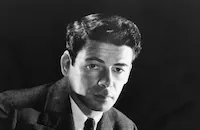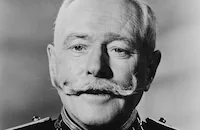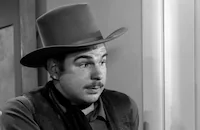Counter-Attack

Brief Synopsis
Cast & Crew
Zoltan Korda
Paul Muni
Marguerite Chapman
Larry Parks
Harro Meller
Roman Bohnen
Film Details
Technical Specs

Synopsis
In 1942, in German-occupied Russia, Russian engineers work under cover of darkness to build a bridge beneath a river facing German lines, over which Russian tanks plan to launch a counter-attack. In preparation for the attack, a group of Baltic paratroopers are assigned to penetrate enemy lines and ascertain the position of enemy reserves. At headquarters, the troopers meet Kostyuk, the commander of the operation, and marvel as he shrewdly interrogates a German prisoner. After Kostyuk introduces them to their guide, Lisa Elenko, the soldiers parachute into a factory near Lubovonov, which the Germans are using as divisional headquarters.
The Russians capture their objective, but in the raid, the factory is severly bombed and collapses. In its subterranean cellar, only Lisa, Alexei Kulkov, one of the paratroopers, and seven German soldiers survive. After taking the Germans prisoner, Alexei finds a German officer's revolver among their possessions and determines to unmask the officer hiding among the enlisted men. Above ground, in the ruins, Alexei's dog claws at the rubble while the sole surviving Russian taps a message to those below. When Alexei responds in code and instructs the Russian to report that a German officer has been captured, the Germans scoff at Alexei's claim until he silences them by showing them the revolver. As Alexei interrogates the Germans, the dog and the Russian steal through the night across enemy lines. When the Russian is killed by German bullets, Alexei's dog continues his trek to headquarters. Meanwhile, in the cellar, Alexei questions Mueller, a professor in civilian life, who begins to rant about an anti-German book that he has written.
When Alexei becomes mesmerized by Mueller's diatribe, the Germans attack. Although Lisa and Alexei fend off their attackers, Lisa is stabbed in the assault. In retaliation, Alexei announces that he intends to kill the Germans, one by one, until he finds their commander. After ordering the sergeant behind a wall, Alexei knocks him out and then fires his gun, causing the Germans to believe that he has killed him. As Alexei confronts his next victim, the man defiantly proclaims that he is Major Ernemann. When the sound of tanks rumble above ground, the major taunts Alexei with images of imminent defeat and suggests that if he is so certain of Russian victory, he should have no qualms about exchanging invasion plans. Alexei, determined to elicit the location of the concentration of German forces, offers to trade information with the major.
After the major pinpoints the site of the German tank division, Alexei shows him the Russian crossing point in the river. In exchange for the name of the village in which the German troops are to assemble, Alexei tells the major about the underwater bridge. Lisa, shocked by Alexei's revelation, urges him to kill the Germans before they can use the information. Alexei rejects Lisa's advice, claiming that he must first ascertain whether the major has told the truth. As the bridge nears completion, Alexei's dog reaches headquarters and then leads the troops across the bridge to his trapped master.
Meanwhile, in the cellar, Alexei pretends to fall asleep and one of the Germans awakens him and offers to be his ally. Alexei then hands the German a rifle and drifts off to sleep. Later he is awakened by the sound of digging. When the major charges toward their rescuers, shouting the Russian plan of attack, Alexei shoots him. Thinking that the German army is breaking into the cellar, Alexei is about to pull the pin in his grenade when he sees his dog and the Russian army burst through the rubble. After Lisa is carried out on a stretcher, Alexei turns over his prisoners and reports the details of the German invasion plan. Taking the rifle from the German's hands, Alexei reveals that it holds no bullets and then collapses from fatigue.

Director

Zoltan Korda
Cast

Paul Muni

Marguerite Chapman

Larry Parks

Harro Meller

Roman Bohnen

George Macready
Erik Rolf
Ludwig Donath
Rudolph Anders
Philip Van Zandt
Frederick Giermann
Paul Andor
Ivan Triesault
Louis Adlon

Ian Wolfe
Trevor Bardette
Richard Hale
Adeline De Walt Reynolds
Virginia Christine
Walter Bonn
Louis Arco
Arno Frey
Al Eben
Robert Love
Danny Craig
Martin Noble
Ted Hecht
Frank Darien

Matt Willis
Fred Graff
William Challee
John Bagni
Mel Schubert
Alfred Allegro

Darren Mcgavin
Rolf Lindau
Gary Bruce
Bob Lowell
George Lynn
Hugh Beaumont
Frank Lackteen
Charles Wagenheim
Crane Whitley
Alan Ward
Walter Pietila
Wilton Graff
George Eldredge
John Vosper
Mel Wilkerson
Otto Reichow
Sven Hugo Borg
Peter Helmers
Richard Bartell
John Gardner
Gene Garrick
Carl Ekberg
Kurt Neumann
Bob Meredith
Jack Lorenz
Leroy Taylor
John Forrest
Wally West
Crew
Earl Bellamy
Lawrence W. Butler
Al Clark
Ray Cory
Jack Goodrich
Stephen Goossón
Louis Gruenberg
Thelma Hoover
James Wong Howe
Edward Jewell
Irving Klein
John Howard Lawson
Juanita Lopez
Russell Malmgren
William Mull
Charles Nelson
Robert Priestley
M. W. Stoloff

Videos
Movie Clip


Trailer
Film Details
Technical Specs

Articles
Counter-Attack
The star of Counter-Attack is played by Paul Muni, in his second World War II movie and once again he is playing a European, not an American. In Commandos Strike at Dawn (1942), Muni was a simple Norwegian fishermen who finds reserves of courage when he resolves to fight the Nazis. In Counter-Attack, he's an ordinary man who meets the challenge of an extraordinary situation. Muni jumped at the chance to do the picture, which he saw as the perfect way to make what he considered the best contribution to the war effort, a story that would illuminate the universal dignity and decency of the human spirit alive in people no matter what their background. He threw himself wholeheartedly into the role, drawing on his experience in comic roles from his Yiddish theater days to come up with moments of clowning built into the script; he is particularly shining in the scene where his character struggles to stay awake after many days without sleep to keep his prisoners under guard.
The US and Soviet Union were, of course, allies at the time, so there were several pictures made during the war with the universality Muni hoped to achieve, painting the Russians in a sympathetic light. Counter-Attack was based on a 1943 stage drama by Janet and Philip Stevenson, itself taken from a Russian play. Although there is nothing anti-American in this movie, it was the type of film that got its creators into trouble a short time after the war ended. Anything putting the Soviet Union in a less than negative light was deemed suspicious by the anti-Communist forces at work in American politics in the late 40s and early 50s, especially if it came from people with backgrounds that included left-wing, social activist work. The Stevensons were one such couple, and they were blacklisted from film work as a result. Janet Stevenson, in fact, also lost her job with the University of Southern California for alleged ties with the Communist Party. They were not the only ones connected with this movie to become victims of the witch-hunts. Sidney Buchman, the Oscar®-winning writer of Here Comes Mr. Jordan (1941) and a nominee for Mr. Smith Goes to Washington (1939), who initiated this production and supervised it for Columbia, was also later blacklisted, as was co-star Larry Parks. The script was adapted by John Howard Lawson, later one of the Hollywood Ten group of film artists who went to jail after refusing to name names to the House Un-American Activities Committee.
Muni had asked for his favorite cameraman Tony Gaudio to shoot Counter-Attack. "Tony knows how to climb inside my face," he said. Gaudio was unavailable, but Muni was delighted by the choice of James Wong Howe as director of photography. The Hollywood veteran had recently been nominated for his work on The North Star (1943), another film about everyday citizens of the Soviet Union under attack by the Germans.
The sole female in the cast was Marguerite Chapman, a former model who appeared in a number of war-themed movies before slipping into supporting roles, such as the secretary in The Seven Year Itch (1955). Chapman was asked to play the role of the elderly Rose Calver in Titanic (1997), but she was too ill and the part went to Gloria Stuart.
Despite mostly good reviews, Counter-Attack did not do well commercially. Its failure was seen as proof that Muni no longer had the appeal of his heyday at Warner Brothers in the 1930s and early 40s. After Angel on My Shoulder (1946), he worked only on television and in one Italian picture until his final feature film appearance in The Last Angry Man (1959). The lackluster box office, however, probably had more to do with timing. The end of the war in Europe coincided with the picture's release, rendering its subject and suspense as passé and already outdated.
Director: Zoltan Korda
Producer: Zoltan Korda (uncredited), uncredited production supervision by Sidney Buchman
Screenplay: John Howard Lawson, based on the play by Philip and Janet Stevenson from the play Pobyeda by Mikhail Ruderman and Ilya Vershinin
Cinematography: James Wong Howe
Editing: Al Clark, Charles Nelson
Art Direction: Stephen Goosson, Edward Jewell
Original Music: Louis Gruenberg
Cast: Paul Muni (Alexei Kulkov), Marguerite Chapman (Lisa Elenko), Larry Parks (Kirichenko), George Macready (Col. Semenov), Ludwig Donath (Prof. Muller).
BW-90m.
by Rob Nixon

Counter-Attack
Quotes
Trivia
Notes
The working title of this film was One Against Seven. The picture opens with the following written prologue: "In 1942 Russia had been invaded to a depth of a thousand miles, and her armies seemed crushed. The world didn't know that these same 'beaten' armies would turn, take back every foot of ground they had lost and then invade Germany itself. One night, in this same year, 1942...under cover of fog...Russian engineers were engaged in a strange activity...on a river, facing the German lines..." According to a pre-production news item in Hollywood Reporter, Eric Feldary tested for the role of "Kirichenko." The Russian village set occupied four acres of land on Columbia's Burbank ranch and location shots were filmed at Charlston Flats, CA, according to a Hollywood Reporter news item. Another news item in Hollywood Reporter adds that additional scenes were shot in late January 1945 to update developments on the Russian-German front.















